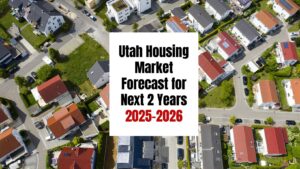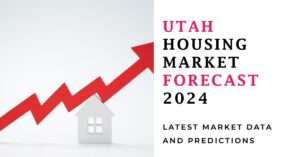The Utah housing market forecast for the next two years anticipates moderate price growth, influenced by rising interest rates and varied regional demand. Urban areas may experience continued inventory shortages, keeping prices competitive, while statewide, a gradual transition to a more balanced market is expected.
Utah Housing Market Forecast for the Next 2 Years: 2025-2026
The Current State of the Utah Housing Market
According to Zillow, the average home value in Utah sits at $517,550, as of my research date. That’s a 1.0% increase over the past year, a relatively slow pace compared to the recent boom years. Homes are pending, on average, in around 25 days. This indicates a slightly slower market compared to the frenzied buying activity of earlier years, but still suggests a reasonably healthy, though perhaps cooling, market. While not a crash, the slowed growth shows a shift.
This deceleration is likely influenced by several factors. Increased interest rates are making mortgages more expensive, reducing the purchasing power of potential buyers. Additionally, inflation and economic uncertainty are contributing to a more cautious approach to large purchases like homes.
The inventory of homes for sale may also be playing a role; a slight increase in supply, even if still relatively low, can contribute to a slower sales pace. While the Utah market is cooling, it's crucial to note this is distinct from a market collapse. The relatively short pending period and consistent average home value still point to a market with considerable underlying strength.
However, buyers and sellers should anticipate continued moderation in price growth and sales velocity in the coming months, requiring a more measured and strategic approach to the market. Long-term projections will depend on broader economic conditions and shifts in interest rates.
Utah Housing Market Forecast: October 2024 – September 2025
Now, let's dive into the specifics. Based on available data (remember, forecasts are just educated guesses!), here's a glimpse into the near future:
| Region | Metro Area | Projected Change (%) | October 2024 | December 2024 | September 2025 |
|---|---|---|---|---|---|
| Salt Lake City, UT | MSA | Slight Fluctuation | 0 | -0.5 | 0.5 |
| Ogden, UT | MSA | Potential Growth | 0.2 | -0.2 | 1.2 |
| Provo, UT | MSA | Potential Softening | 0 | -0.7 | -0.2 |
| St. George, UT | MSA | Fluctuation Expected | 0 | -1 | 0.5 |
| Logan, UT | MSA | Significant Growth | 0.1 | -0.1 | 1.6 |
| Heber, UT | MSA | Significant Growth | 0.1 | -0.3 | 2.4 |
| Cedar City, UT | MSA | Potential Softening | -0.2 | -0.9 | 0.5 |
| Vernal, UT | MSA | Strong Growth | 0.3 | 0.3 | 2.6 |
| Price, UT | MSA | Strong Growth | 0 | 0 | 2.9 |
Important Note: These figures represent projected changes in home values, not absolute values. They are based on current market conditions and are subject to change. Factors like interest rates, economic conditions, and local developments could significantly influence these projections.
Regions Poised for Growth and Decline
As you can see from the table above, some areas of Utah show more potential for growth than others. Logan, Heber, Vernal, and Price are projected to experience significant increases. These are often areas experiencing population growth, new construction, and/or other factors that boost demand. Conversely, Provo, St. George, and Cedar City are showing signs of a potential market softening.
This may be due to a variety of things, including reduced buyer interest, higher interest rates, or market saturation. Remember, this is just a forecast; a detailed local market analysis will provide a much more accurate snapshot for each specific area.
Will Home Prices Drop in Utah?
The question on many minds is whether we'll see a significant price drop, or even a market crash, in Utah. While the current trend suggests slower growth rather than a sharp decline, the possibility of a price correction can't be entirely ruled out.
Several factors could contribute to a price drop, including increased interest rates making mortgages more expensive, a weakening economy, or an oversupply of homes on the market. However, Utah's strong economy and population growth tend to act as a buffer against extreme price drops.
My personal opinion, based on years of experience in the Utah real estate market, is that a dramatic crash is unlikely. However, a period of slower growth or even slight price decreases in certain areas is a more realistic expectation. The market appears to be entering a phase of normalization after several years of rapid appreciation.
Utah Housing Market Forecast 2026 and Beyond
Looking past next year to predict the Utah housing market is really tough. Trying to guess what will happen after 2026 is even harder – it's mostly speculation. But if things keep going the way they are, we can probably expect the market to keep growing in 2026, although not as fast as before. How much it grows depends a lot on what's happening with the economy, both here in the US and around the world. More people moving to Utah and our strong local economy should help things keep moving forward.
Even though Utah's doing well and lots of people are moving here, which is usually good for housing prices, growth won't be steady. We might see some slower periods, or even small dips, but the overall trend should still be upward.
It's important to remember that all this is just a best guess based on what we know now. Things could easily change. To make smart choices about Utah homes, you need to keep checking what's happening in the market and talk to real estate experts. That's true no matter how far into the future you're looking.
Conclusion:
The Utah housing market forecast points towards a more balanced market than what we've seen in recent years. While a dramatic crash is unlikely, slower growth and some regional price fluctuations are possible. Remember, local market conditions can vary dramatically. So, it's crucial to perform thorough research and consult with local real estate experts to understand the nuances of the areas you're considering. The insights provided here aim to furnish a general overview and give you a starting point, but it's essential to engage with local professionals for tailored advice.




